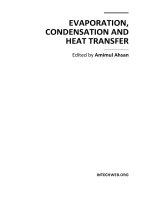Evaporation Condensation and Heat transfer Part 5 potx
Bạn đang xem bản rút gọn của tài liệu. Xem và tải ngay bản đầy đủ của tài liệu tại đây (1.07 MB, 40 trang )
Part 2
Condensation and Cooling
7
Steam Condensation in the Presence of a
Noncondensable Gas in a Horizontal Tube
Kwon-Yeong Lee and Moo Hwan Kim
Korea Atomic Energy Research Institute / Pohang University of Science and Technology,
Republic of Korea
1. Introduction
Perhaps the most common flow configuration in which a convective condensation occurs is
a flow in a horizontal circular tube. This configuration is encountered in air-conditioning
and refrigeration condensers as well as condensers in Rankine power cycles. Although a
convective condensation is also sometimes contrived to occur in a co-current vertical
downward flow, a horizontal flow is often preferred because the flow can be repeatedly
passed through the heat exchanger core in a serpentine fashion without trapping liquid or
vapor in the return bends. (Carey, 1992)
Horizontal heat exchangers are also widely used in the nuclear industry. Recently, a
horizontal heat exchanger design has been proposed for a passive containment cooling
system (PCCS) of future light water reactors. Current PCCS designs typically employ a
vertical condenser. The horizontal design is proposed because horizontal heat exchangers
have a potentially higher heat removal capability than vertical heat exchangers. (Wu &
Vierow, 2006b)
As well as, horizontal heat exchangers have less tube fouling, higher structural earthquake
resistance which will improve the reliability of the safety system, and a large economic
benefit because the shorter coolant pool allows for reduction in the containment height and
volume. In spite of these advantages, there is a lack of mechanistic understanding of the
heat transfer and fluid flow phenomena occurring in the heat exchanger tubes. This is
mainly due to the fact that the phenomena are more complicated compared to the case of
vertical heat exchangers. In vertical tubes the phenomena is mainly laminar or turbulent
film condensation, whereas in horizontal tubes, the phenomena is complicated by strong
asymmetry and flow regime transitions, which causes transitions in heat and mass transfer
mechanisms. There is also the need for mechanistic analysis tools that can assess condenser
performance. (Wu, 2005)
There were many investigations for the condensation phenomena inside horizontal tubes to
study the horizontal heat exchangers. However, almost all of them obtained tube section-
averaged data without a noncondensable gas. Recently, Wu and Vierow (2006a, 2006b)
studied experimentally the condensation of steam in a horizontal heat exchanger with air
present, as shown in Fig. 1. In order to measure the condenser tube inner surface
temperatures and to calculate the local heat fluxes, they developed an innovative
thermocouple design that allowed for nonintrusive measurements. The experimental results
show that the top of the condenser tube is a much better heat transfer surface. At any tube
Evaporation, Condensation and Heat Transfer
154
cross section with condensation, the local heat flux and heat transfer coefficient at the top
part of the tube are higher than those at the bottom of the tube. This is mainly due to the
thinner liquid film at the top of the tube. For this experiment conditions, the flow regime
along most of the tube length are wavy flow and stratified flow, annular flow only exists at
the inlet of the highest steam flow rate.
(a) Temperature measurement cross-section
(b) Temperature distribution of Test No. 99
Fig. 1. Brief review of Wu and Vierow’s experiment
Here, we developed a theoretical model using the heat and mass transfer analogy and the
Rosson and Meyers (1965) correlation to analyze a steam condensation with a
noncondensable gas in horizontal tubes. Furthermore, we applied an empirical correlation
proposed by Lee and Kim (2008) for the vertical tube to estimate condensation heat transfer
coefficient of steam/noncondensable gas mixture in a horizontal tube.
2. Theoretical model
Figure 2 depicts the problem under investigation schematically. The condensate film flows
in the axial direction due to its initial momentum and interfacial shear. Due to the effect of
Steam Condensation in the Presence of a Noncondensable Gas in a Horizontal Tube
155
gravity, the condensate film on the tube inner surface may run down the periphery of the
tube and accumulate in the bottom of the tube. Since the liquid layer acts as a resistance to
heat and mass transfer, it is important to know the two-phase geometric configuration in the
tube cross section.
Fig. 2. Horizontal co-current annular flow with condensation
It is assumed that the vapor entering the tube is saturated. The inside wall temperatures of
the tube are T
w,top
and T
w,bot
, which are lower than the saturation temperature of the vapor.
Therefore, condensation takes place on the wall surface. The vapor/noncondensable gas
mixture has a given inlet bulk temperature T
b
, and a corresponding inlet concentration of
the noncondensable gas W
nc,b
at the given pressure. At the liquid/gas interface, the
temperatures T
i,top
and T
i,bot
, and the noncondensable gas mass fraction W
nc,i,top
and W
nc,i,bot
are unknown and must be determined from the analysis. The analysis of steam
condensation in the presence of a noncondensable gas typically involves the heat balance at
the liquid/gas interface. However, separate models for the condensate film and
vapor/noncondensable gas mixture are linked and solved simultaneously for the heat and
mass transfer rates.
The heat transfer through the vapor/noncondensable gas mixture boundary layer consists
of the sensible heat transfer and the latent heat transfer given up by the condensing vapor,
and it must equal that from the condensate film to the tube wall. Therefore, we get
()()()
fi w c s b i
hT T h h T T−=+ −
(1)
where h
f
is the film heat transfer coefficient, h
c
and h
s
are the condensation and sensible heat
transfer coefficients in the gas mixture respectively.
Then, the total heat transfer coefficient
h
tot
is given by
1
11
tot
fcs
h
hhh
−
⎡
⎤
⎢
⎥
=+
+
⎢
⎥
⎣
⎦
. (2)
To get the cross section-averaged heat transfer coefficient, a parameter β was defined as the
fraction of the perimeter over which film condensation occurred, and correlated as a
function of the liquid and vapor Reynolds numbers and also the ratio of gravitational force
to the viscous force. The following correlations for β were suggested by Wu (2005) based on
Rosson and Meyers (1965).
Evaporation, Condensation and Heat Transfer
156
0.1
0.27 Re
mix
β
= for
0.6 0.5
5
Re Re
6.4 10
mix l
Ga
<× (3)
5
1.74 10
Re Re
mix l
Ga
β
−
×
= for
0.6 0.5
5
Re Re
6.4 10
mix l
Ga
>× (4)
Then, the circumferentially averaged heat flux can be calculated as
"" "
(1 )
tot top bot
qq q
ββ
=+−
(5)
Here, the heat fluxes at the top and bottom of the horizontal tube are defined as
"
,,
()
to
p
tot to
p
bwto
p
qh TT=−
(6)
"
,,
()
bot tot bot b w bot
qh TT=−
(7)
2.1 Condensate flow
For stratified flow with higher vapor velocity, the vapor shear will affect the drain of the
liquid and also change the mode of heat transfer at the bottom of the tube through the liquid
pool from conduction to forced convection. Rosson and Meyers (1965) measured a single
point value of the heat transfer coefficient for stratified, wavy and slug flows for methanol
and acetone at atmospheric pressure. By rotating the condenser tube, they measured the
variation of the heat transfer coefficient continuously decreased from the top of the tube to
the bottom of the tube. They proposed different heat transfer correlations for top and
bottom side of the tube.
For top side of the tube, the heat transfer is similar to that of Nusselt but the effect of vapor
shear is included:
1/4
31
0.12
()
0.31Re
()
ll vllv
top mix
li w
gkh
h
TTd
ρρ ρ
μ
⎡
⎤
−
=
⎢
⎥
−
⎢
⎥
⎣
⎦
. (8)
Here, the Re
mix
represents the effect of vapor shear.
For the bottom of the tube, no noticeable dependency of the Nu on the temperature was
observed. The heat transfer coefficient depended on the vapor and liquid flow rate. The von
Karman analogy between momentum transfer and heat transfer was used to predict the heat
transfer coefficient.
,
8Re
5
5ln(5Pr1)
Pr
lvt l
l
bot
k
h
d
Φ
=⋅
++
. (9)
Here the parameter Φ is the two-phase multiplier for viscous laminar liquid flow and
turbulent vapor flow, as presented by the Martinelli parameter with C=12.
1/2
2
1
1
l
C
X
X
⎛⎞
Φ= + +
⎜⎟
⎝⎠
(10)
Steam Condensation in the Presence of a Noncondensable Gas in a Horizontal Tube
157
where we used Martinelli correlation as
0.5 0.1
0.9
1
vl
tt
lv
x
X
x
ρμ
ρμ
⎛⎞⎛⎞
−
⎛⎞
=
⎜⎟⎜⎟
⎜⎟
⎜⎟⎜⎟
⎝⎠
⎝⎠⎝⎠
(11)
2.2 Vapor/noncondensable gas mixture flow
In this study, a stratification of the noncondensable gas concentration in the gas phase was
assumed to be negligible, so the heat and mass transfer mechanism at everywhere inside the
horizontal tube can be considered same. And the heat and mass transfer analogy was used
to analysis steam condensation with noncondensable air in horizontal tubes. Therefore, the
sensible and latent heat transfer rates can be calculated simultaneously.
The sensible heat transfer coefficient can be expressed as
mix
smix
i
k
hNu
d
= (12)
and the condensation (or latent) heat transfer coefficient can be defined as
"
()
cond fg
c
bi
mi
h
TT
=
−
. (13)
To find
"
cond
m , the mass balance at the interface is calculated to yield the following equation:
""
,
()
v
cond v i tot i
i
W
mDWm
y
ρ
⎡⎤
∂
=− +
⎢⎥
∂
⎣⎦
. (14)
As the condensate surface is impermeable to the noncondensable gases, we can think
"
,
()
nc
nc i tot i
i
W
DWm
y
ρ
⎡⎤
∂
=
⎢⎥
∂
⎣⎦
. (15)
Also, as the sum of vapor and noncondensable gas mass fractions is unit, we can derive
nc v
WW
yy
∂∂
=−
∂∂
. (16)
Solving for
"
tot
m
from Eq. (15) and substituting it in Eq. (14) together with Eq. (16), Eq. (14)
can be simplified as
,,
"
,,
()
((/))
1(1)
vb vi
vi
cond m
vi vi
WW
DW y
mh
WW
ρ
−
−∂ ∂
==
−−
, (17)
where h
m
is the mass transfer coefficient. Eq. (17) can be recast as
"
,
,,
()
nc i
cond
mix
nc i nc b
W
md
Sh
DW W
ρ
=
−
. (18)
Evaporation, Condensation and Heat Transfer
158
The modifications necessary to incorporate the condensate film roughness, developing flow,
and suction effect on the heat and mass transfer involve modifying the Nusselt and
Sherwood numbers, as discussed below.
2.2.1 Interface roughness
Film roughness increases the heat transfer from the gas phase by influencing the turbulence
pattern close to the interface and disrupting the gaseous laminar sublayer. A method to
consider the effect of a wavy surface was considered with the concept of the simple model of
Kim and Corradini (1990), which applies the mixing length theory presented by Kays and
Crawford (1980) for a rough surface to the momentum, thermal, and mass concentration
boundary layer.
The local Nusselt and Sherwood numbers without suction for a smooth tube are calculated
using Gnielinski correlation as
,
1/2 2/3
( / 8)(Re 1000)Pr
1 12.7( /8) (Pr 1)
os
f
Nu
f
⎡
⎤
−
=
⎢
⎥
+−
⎢
⎥
⎣
⎦
(19)
,
1/2 2/3
( / 8)(Re 1000)
1 12.7( /8) ( 1)
os
fSc
Sh
fSc
⎡
⎤
−
=
⎢
⎥
+−
⎢
⎥
⎣
⎦
(20)
for 2300 ≤ Re ≤ 5 × 10
6
, Nu
o,s
= Sh
o,s
= 3.66; for Re ≤ 2300, f is a Moody friction factor here only.
Then, using the corrections suggested by Norris for the roughness of the heat transfer surface
,,
n
r
or os
s
f
Nu Nu
f
⎛⎞
=
⎜⎟
⎜⎟
⎝⎠
(21)
,,
n
r
or os
s
f
Sh Sh
f
⎛⎞
=
⎜⎟
⎜⎟
⎝⎠
, (22)
where
0.215 0.215
0.68Pr 0.68nSc== and
0.25
0.0791Re
s
f
−
= .
Here, the rough wall friction factor f
r
is calculated using Whalley and Hewitt correlation for
pressures higher than 10
5
Pa as
1/3
124
l
rs
mix
ff
d
ρ
δ
ρ
⎡
⎤
⎛⎞
⎢
⎥
=+
⎜⎟
⎜⎟
⎢
⎥
⎝⎠
⎣
⎦
. (23)
2.2.2 Suction effect
In the vapor/noncondensable gas layer, the condensation process leads to thinning of the
boundary layer, which is called the suction effect. This means that at the interface, the
velocity component normal to the wall is not zero. Kays and Moffat obtained the following
correlation for a boundary layer subject to suction experimentally:
Steam Condensation in the Presence of a Noncondensable Gas in a Horizontal Tube
159
1
ln
h
oh
B
St
St B
⎛⎞
+
=
⎜⎟
⎜⎟
⎝⎠
, (24)
where
/
hcond
Bm GSt
∞
′′
=
is called the suction parameter. We defined St as Stanton number
with suction and St
o
as Stanton number without suction. This equation can be recast as
1
1
"
"
,
Re Pr
exp 1
Re Pr
cond x
x
ox cond x
m
G
Nu
GNu m
−
−
∞
∞
⎡⎤
⎛⎞
⎡
⎤
⎢⎥
⎜⎟
=−
⎢
⎥
⎜⎟
⎢⎥
⎢
⎥
⎣
⎦
⎝⎠
⎣⎦
. (25)
Using the analogy between heat and mass transfer, Eq. (25) can be written as
1
1
"
"
,
Re
exp 1
Re
cond x
x
ox cond x
mSc
G
Sh
GSh m Sc
−
−
∞
∞
⎡⎤
⎛⎞
⎡
⎤
⎢⎥
⎜⎟
=−
⎢
⎥
⎜⎟
⎢⎥
⎢
⎥
⎣
⎦
⎝⎠
⎣⎦
. (26)
Combining Eqs. (18) and (26), we get
"
cond
m
as follows:
,
"
Re (1 )
ln 1
Re
ox
x
cond
x
GSh
ScD
m
Sc
Gd
ρω
∞
∞
⎡
⎤
−
⎧
⎫
=+
⎨
⎬
⎢
⎥
⎩⎭
⎣
⎦
, (27)
where ω is the ratio of the noncondensable gas mass fraction in the bulk to that at the
liquid/gas interface. And the noncondensable gas mass fractions in the bulk and the
interface are given by the Gibbs-Dalton ideal gas mixture equation.
2.2.3 Developing flow
As most of the heat transfer takes place in the first part of the condenser tube, it may be
important to consider the developing flow effect in the heat and mass transfer model.
Therefore, the suggestion of Reynolds et al. (1969) is adopted for the thermal entrance zone,
and is given by
43/2
,
0.8(1 7 10 Re )
1
/
ot o
Nu Nu
xd
−
⎡
⎤
+×
=+
⎢
⎥
⎢
⎥
⎣
⎦
(28)
43/2
,
0.8(1 7 10 Re )
1
/
ot o
Sh Sh
xd
−
⎡
⎤
+×
=+
⎢
⎥
⎢
⎥
⎣
⎦
. (29)
2.3 Calculation procedure
The calculation commences at the tube inlet for which the inlet mixture temperature, inlet
steam flow rate, inlet noncondensable gas flow rate, and total pressure are given. Here, the
pressure drop through the condenser tube is assumed to be negligible. The inner wall
temperature profiles on top and bottom of a horizontal tube are given as boundary
conditions. The heat fluxes through the liquid film and mixture boundary layer are
calculated separately with an assumed interface temperature. Iteration is needed to get
reasonable heat transfer coefficients of h
f
, h
c
, and h
s
by modifying the interface temperature
until the heat fluxes converge within a specified accuracy. The condensing tube is divided
Evaporation, Condensation and Heat Transfer
160
into axial control volumes of a specific size of 1 mm. The calculation procedure at each axial
location of the tube is explained in Fig. 3.
Start
Input data I.C. & B.C.
Initial properties at each node
Initial guess of interfacial properties
Physical properties(Liquid & Mixture)
Film HTC, mixture flow rate
fs -> fr -> Nuo,x ; Sho,x -> Nuo,r ; Sho,r
-> Nuo,t ; Sho,t -> m”cond -> Nux
() ()
f
i w cond fg s b i
hT T m H hT T
′′
−= + −
Last node or Re < 0 ?
End
No
No
Yes
Yes
Node size = 1-mm
No
Top
Bottom
Fig. 3. Calculation procedure
2.4 Results and discussions
Figures 4-6 present the modelling results for Test No. 99. In this experimental case the inlet
mixture Reynolds number was 42,102, inlet air mass fraction was 5.1 %, and the system
pressure was 0.202 MPa. Figure 4 shows the distribution of the calculated local
temperatures. Even though the bottom wall temperature is lower than the top wall
temperature, the interface temperature at bottom is higher than that at top. Therefore, the
temperature gradient through the liquid pool at the bottom side is larger than that through
the liquid film at the top side. The reason is a thickness of the condensate film.
0.0 0.5 1.0 1.5 2.0 2.5 3.0
40
60
80
100
120
140
160
Test No. 99
Inlet mixture Re = 42102
Inlet mass fraction of air = 5.1 %
Pressure = 0.202 MPa
Theoretical model:
T
b
T
w,top
T
i,top
T
w,bot
T
i,bot
Axial location (m)
Temperature (
o
C)
Exp. data:
T
b
T
w,top
T
w,bot
Fig. 4. Calculated temperature distribution for Test No. 99
Steam Condensation in the Presence of a Noncondensable Gas in a Horizontal Tube
161
Figure 5 shows the variation in the condensate film, condensation, and sensible heat
transfer coefficients, as well as the total heat transfer coefficient. The sensible heat transfer
coefficient is negligibly small. At the bottom of the horizontal tube, the condensation
resistance defined as 1/h
c
is much smaller that the film resistance defined as 1/h
f
. This
means that the film acts in a dominant role for heat transfer. So, it is very important to use
elaborate film heat transfer models for the bottom side. At the top of it, the film heat
transfer coefficient is large and comparative with the condensation heat transfer
coefficient. Therefore, we should carefully consider the model for the
steam/noncondensable gas mixture boundary layer for the top side. From this figure, we
can see that the theoretical model slightly underestimates the experimental data at the top
of the tube and over-predicts the data at the bottom of it.
0.00.51.01.52.02.5
0
5
10
15
20
Test No. 99 : Top of tube
Inlet mixture Re = 42102
Inlet mass fraction of air = 5.1 %
Pressure = 0.202 MPa
Heat transfer coefficient ( KW/m
2
K)
Axial location (m)
h
film
h
c
h
s
h
tot
Exp. data
0.00.51.01.52.02.5
0
5
10
15
20
Test No. 99 : Bottom of tube
Inlet mixture Re = 42102
Inlet mass fraction of air = 5.1 %
Pressure = 0.202 MPa
Heat transfer coefficient ( KW/m
2
K)
Axial location (m)
h
film
h
c
h
s
h
tot
Exp. data
Fig. 5. Comparison of experimental HTCs with theoretical model for Test No. 99
Figure 6 presents that the heat fluxes at the top and at the bottom of the tube are similar to
each other. The reason is that even though the heat transfer coefficients at the top are larger
than those of the bottom, the temperature gradients are smaller at the top as explained in
Fig. 4.
Evaporation, Condensation and Heat Transfer
162
0.0 0.5 1.0 1.5 2.0 2.5 3.0
0
100
200
300
400
500
Test No. 99
Inlet mixture Re = 42102
Inlet mass fraction of air = 5.1 %
Pressure = 0.202 MPa
Heat flux ( KW/m
2
)
Axial location
(
m
)
Theoretical model of Top
Theoretical model of Bottom
Exp. data of Top
Exp. data of Bottom
Fig. 6. Comparison of experimental Heat Flux with theoretical model for Test No. 99
0.0 0.5 1.0 1.5 2.0 2.5 3.0
0
5
10
15
20
Test No. 9
Inlet mixture Re = 49679
Inlet mass fraction of air = 15.3 %
Pressure = 0.116 MPa
Heat transfer coefficient ( KW/m
2
K)
Axial location (m)
Theoretical model of Top
Theoretical model of Bottom
Exp. data of Top
Exp. data of Bottom
Fig. 7. Comparison of experimental HTCs with theoretical model for Test No. 9
0.0 0.5 1.0 1.5 2.0 2.5 3.0
0
100
200
300
400
500
Test No. 9
Inlet mixture Re = 49679
Inlet mass fraction of air = 15.3 %
Pressure = 0.116 MPa
Heat flux ( KW/m
2
)
Axial location (m)
Theoretical model of Top
Theoretical model of Bottom
Exp. data of Top
Exp. data of Bottom
Fig. 8. Comparison of experimental Heat Flux with theoretical model for Test No. 9
The modelling results for the Test No. 9 are shown in Figs. 7 and 8. Here, the inlet mixture
Reynolds number was 49.679, inlet air mass fraction was 15.3 %, and the system pressure
Steam Condensation in the Presence of a Noncondensable Gas in a Horizontal Tube
163
was 0.116 MPa. Comparing with Test No. 99, the heat transfer coefficients and the heat
fluxes are decreased since the noncondensable gas effect by air is stronger. The general
trends for the heat transfer coefficient and heat flux are similar with the Test No. 99. So, we
can say that the developed theoretical model may be used to predict the steam condensation
heat transfer coefficients in the presence of noncondensable gas inside horizontal tubes.
Figure 9 shows that a steam flow rate of Test No. 9 is well estimated, but that of Test No. 99
has some discrepancy between experimental data and modelling results. Specially, we can
see almost all steam was condensed inside tube in experiment, but the steam still remains at
the end of the tube in modelling due to under-estimated heat flux.
0.0 0.5 1.0 1.5 2.0 2.5 3.0
0.000
0.002
0.004
0.006
0.008
0.010
0.012
Steam flow rate ( kg/s)
Axial location (m)
Theoretical model of Test No. 9
Theoretical model of Test No. 99
Exp. data of Test No. 9
Exp. data of Test No. 99
Fig. 9. Comparison of Steam flow rate for Test No. 9 and 99
Figures 10 and 11 present the modelling results for Test No. 45 which had higher inlet
mixture Reynolds number comparing with Test No. 9. The inlet mixture Reynolds number
was 175,956, inlet air mass fraction was 15.4 %, and the system pressure was 0.401 MPa. The
heat transfer coefficients and heat fluxes are increased because the interfacial shear stress is
stronger in Test No. 45. We can guess that the estimated steam flow rate will be rapidly
decreased than the measured data because the heat fluxes are larger in the theoretical model
at the top. This will be shown in Fig. 14.
0.0 0.5 1.0 1.5 2.0 2.5 3.0
0
5
10
15
20
Test No. 45
Inlet mixture Re = 175956
Inlet mass fraction of air = 15.4 %
Pressure = 0.401 MPa
Heat transfer coefficient ( KW/m
2
K)
Axial location (m)
Theoretical model of Top
Theoretical model of Bottom
Exp. data of Top
Exp. data of Bottom
Fig. 10. Comparison of experimental HTCs with theoretical model for Test No. 45
Evaporation, Condensation and Heat Transfer
164
0.0 0.5 1.0 1.5 2.0 2.5 3.0
0
100
200
300
400
500
Test No. 45
Inlet mixture Re = 175956
Inlet mass fraction of air = 15.4 %
Pressure = 0.401 MPa
Heat flux ( KW/m
2
)
Axial location (m)
Theoretical model of Top
Theoretical model of Bottom
Exp. data of Top
Exp. data of Bottom
Fig. 11. Comparison of experimental Heat Flux with theoretical model for Test No. 45
2.5 Empirical correlation
Lee and Kim (2008a) proposed a new empirical correlation to estimate the condensation
heat transfer coefficients of steam/noncondensable gas mixture in vertical tube. They
found that the interfacial shear stress increases as the condenser tube diameter decreases
for the same mixture Reynolds number and the condensation heat transfer coefficients
also increase due to the interfacial shear stress. Because the effect of the interfacial shear
stress was not sufficiently considered in previous empirical correlations using the
Reynolds number, they could not estimate well various experimental data obtained from
different condenser tube diameter. On the other hand, Lee and Kim (2008a) used the
dimensionless shear stress and noncondensable gas mass fraction to develop a new
correlation. They showed that the new correlation could predict the experimental data
well with 17.5 ~ 27.5 % standard deviations irrespective of the condenser tube diameter as
shown in Fig. 12.
0.1 1 10 100
0.1
1
10
100
Simple model using
Lee and Kim's correlation
Data:
Siddique et al.
Kuhn et al.
Lee and Kim
HTCs from model ( KW/m
2
K)
HTCs from experiement ( KW/m
2
K)
Fig. 12. Comparison of experimental HTCs with empirical correlation for vertical tubes
Steam Condensation in the Presence of a Noncondensable Gas in a Horizontal Tube
165
Their correlation is shown as
* 0.3124 0.402
exp,
/ (1 0.964 )
mix pure mix nc
fh h W
τ
==−
(30)
for
*
0.06 46.65
mix
τ
<< and 0.038 0.814
nc
W<< . Here, the dimensionless shear stress is
defined as
2
*
1/2
mix mix
mix
mix
ff
uf
gL gL
ρ
τ
τ
ρρ
⋅
==
(31)
where
Re /
mix mix mix mix
ud
μρ
= ,
()
1/3
2
/
f
Lg
ν
= , and
1/4
0.079Re
mix
f
−
= for Re
mix
> 2300 or
16 / Re
mix
f = for Re
mix
< 2300. And they used Nusselt theory (1916) to calculate h
pure
for the
vertical tube.
In this study, we should keep in mind that the problem geometry is not a vertical tube but a
horizontal tube, and the heat and mass transfer mechanism in the gas phase at everywhere
inside the horizontal tube is already assumed same. Therefore, degradation factor will be
same regardless of top or bottom. On the other hand, the film heat transfer mechanism at
the top side is definitely different with that at the bottom side. At the top side, the
condensate film is thin due to the effect of gravity and Chato (1962) correlation will be
proper to describe the pure steam condensation heat transfer. At the bottom side, however,
the condensate film becomes thick following the axial direction like the condensation
phenomena on vertical wall. So, Nusselt theory will be proper to calculate the pure steam
condensation heat transfer coefficient at the bottom side. Chato correlation for the top and
Nusselt theory for the bottom are given by
1/4
3'
,
()
0.725
()
ll vllv
pure top Chato
lsat w
gkh
hh
TTD
ρρ ρ
μ
⎡
⎤
−
==
⎢
⎥
−
⎢
⎥
⎣
⎦
(32)
1/4
3'
,
()
4( )
ll vllv
pure bot Nusselt
lsat w
gkh
hh
TTx
ρρ ρ
μ
⎡
⎤
−
==
⎢
⎥
−
⎢
⎥
⎣
⎦
. (33)
The calculated heat transfer coefficient h
exp,mix
from Eq. (30) is the total heat transfer
coefficient h
tot
in Eq. (2).
Figure 13 shows that the predictions using the Lee and Kim’s empirical correlation are very
similar with the results from theoretical model except the bottom of Test No. 45. But, if we
see Fig. 14, the shapes of steam flow rate are almost same between the theoretical model and
the empirical model. So, we suggest the Lee and Kim’s correlation to calculate the
condensation heat transfer coefficients of steam/noncondensable gas mixture irrespective of
not only the condenser tube diameter, but also orientation.
Evaporation, Condensation and Heat Transfer
166
0.0 0.5 1.0 1.5 2.0 2.5 3.0
0
5
10
15
20
Test No. 99
Inlet mixture Re = 42102
Inlet mass fraction of air = 5.1 %
Pressure = 0.202 MPa
Heat transfer coefficient ( KW/m
2
K)
Axial location (m)
Exp. data (Top of tube)
Theoretical model
Chato + Lee & Kim factor
0.0 0.5 1.0 1.5 2.0 2.5 3.0
0
5
10
15
20
Test No. 99
Inlet mixture Re = 42102
Inlet mass fraction of air = 5.1 %
Pressure = 0.202 MPa
Heat transfer coefficient ( KW/m
2
K)
Axial location (m)
Exp. data (Bottom of tube)
Theoretical model
Nusselt + Lee & Kim factor
0.0 0.5 1.0 1.5 2.0 2.5 3.0
0
5
10
15
20
Test No. 9
Inlet mixture Re = 49679
Inlet mass fraction of air = 15.3 %
Pressure = 0.116 MPa
Heat transfer coefficient ( KW/m
2
K)
Axial location (m)
Exp. data (Top of tube)
Theoretical model
Chato + Lee & Kim factor
0.0 0.5 1.0 1.5 2.0 2.5 3.0
0
5
10
15
20
Test No. 9
Inlet mixture Re = 49679
Inlet mass fraction of air = 15.3 %
Pressure = 0.116 MPa
Heat transfer coefficient ( KW/m
2
K)
Axial location (m)
Exp. data (Bottom of tube)
Theoretical model
Nusselt + Lee & Kim factor
0.0 0.5 1.0 1.5 2.0 2.5 3.0
0
5
10
15
20
Test No. 45
Inlet mixture Re = 175956
Inlet mass fraction of air = 15.4 %
Pressure = 0.401 MPa
Heat transfer coefficient ( KW/m
2
K)
Axial location (m)
Exp. data (Top of tube)
Theoretical model
Chato + Lee & Kim factor
0.0 0.5 1.0 1.5 2.0 2.5 3.0
0
5
10
15
20
Test No. 45
Inlet mixture Re = 175956
Inlet mass fraction of air = 15.4 %
Pressure = 0.401 MPa
Heat transfer coefficient ( KW/m
2
K)
Axial location (m)
Exp. data (Bottom of tube)
Theoretical model
Nusselt + Lee & Kim factor
Fig. 13. Comparison of experimental HTCs and Heat Flux with empirical correlation for Test
No. 9, 99 and 45
Steam Condensation in the Presence of a Noncondensable Gas in a Horizontal Tube
167
0.0 0.5 1.0 1.5 2.0 2.5 3.0
0.00
0.01
0.02
0.03
0.04
0.05
Test No. 45
Inlet mixture Re = 175956
Inlet mass fraction of air = 15.4 %
Pressure = 0.401 MPa
Steam flow rate ( kg/s)
Axial location (m)
Exp. data
Theoretical model
Emphirical correlation
Fig. 14. Comparison of steam flow rate for Test No. 45
3. Conclusion
A theoretical model is developed to investigate a steam condensation with a
noncondensable gas in a horizontal tube using the heat and mass analogy. The total heat
transfer coefficient is given by the film, condensation and sensible heat transfer coefficients.
For stratified flow with high vapor velocity, the vapor shear will affect the drain of the
liquid and also change the mode of heat transfer at the bottom of the tube through the liquid
pool from conduction to forced convection. The film heat transfer coefficients of the upper
and lower sides of the tube were calculated separately from Rosson and Meyers (1965)
correlation. The heat and mass analogy was used to analysis the steam/noncondensable gas
mixture boundary layer. Here, the Nusselt and Sherwood numbers in the gas phase were
modified to incorporate the effects of condensate film roughness, suction, and developing
flow. The theoretical model slightly underestimated the experimental heat transfer
coefficients at the top of the tube. On the other hand, the model slightly over-predicted the
data at the bottom of it. And the heat fluxes at the upper and lower sides of the tube were
similar to each other. Generally speaking, the model predictions showed a good agreement
with experimental data.
The new empirical correlation proposed by Lee and Kim (2008) for the vertical tube was
applied to the condensation of steam/noncondensable mixture in a horizontal tube. Nusselt
theory and Chato correlation were used to calculate the heat transfer coefficients at top and
bottom of the horizontal tube, respectively. The predictions of the new empirical correlation
were good and very similar with the theoretical model.
4. Acknowledgment
This work has been carried out under the support from the Project of Power Industry
Research and Development Fund given by the Ministry of Knowledge Economy.
5. References
Carey, Van P. (1992). Liquid-Vapor Phase-Change Phenomena, Taylor & Francis, ISBN 0-56032-
074-5, Hebron KY, USA
Evaporation, Condensation and Heat Transfer
168
Kays, W. M. & Crawford, M. E. (1980). Convective Heat and Mass Transfer, MaGraw-Hill,
ISBN 0-07-033457-9, New York, USA
Reynolds, H. C. ; Swearingen, T. B. & McEligot, D. M. (1969). Thermal Entry for Low
Reynolds Number Turbulent Flow, Journal of Basic Engineering, Vol.91, pp.87-94,
ISSN 0021-9223
Wu, T. & Vierow, K. (2006a). A Local Heat Flux Measurement Technique for Inclined Heat
Exchanger Tubes, Experimental Heat Transfer, Vol.19, pp.1-14, ISSN 1521-0480
Wu, T. & Vierow, K. (2006b). Local Heat Transfer Measurements of Steam/Air Mixtures in
Horizontal Condenser Tubes, International Journal of Heat Mass Transfer, Vol.49,
pp.2491-2501, ISSN 0017-9310
Wu, T. (2005). Horizontal In-Tube Condensation in the Presence of a Noncondensable Gas,
Ph. D. Dissertation, Purdue University, USA
Chato, J. C. (1962). Laminar Condensation inside Horizontal and Inclined Tubes, ASHRAE
journal, Vol. 4, pp.52-60, ISSN 0001-2491
Kim, M. H. & Corradini, M. L. (1990). Modeling of condensation heat transfer in a reactor
containment, Nuclear Engineering and Design, Vol. 118, pp. 193-212, ISSN 0029-
5493
Lee, K Y. & Kim, M. H. (2008a). Experimental and empirical study of steam condensation
heat transfer with a noncondensable gas in a small-diameter vertical tube, Nuclear
Engineering and Design, Vol. 238, pp. 207-216, ISSN 0029-5493
Lee, K Y. & Kim, M. H. (2008b). Effect of an interfacial shear stress on steam condensation
in the presence of a noncondensable gas in a vertical tube, International Journal of
Heat Mass Transfer, Vol.51, pp.5333-5343, ISSN 0017-9310
Nusselt, W. A., (1916). “The surface condensation of water vapor”, Zeitschrift Ver. Deut.
Ing., Vol. 60, pp. 541-546
Rosson, H. F. & Mayers, J. A. (1965). Point values of condensing film coefficients inside a
horizontal tube, Chemical Engineering Progress Symposium Series, Vol. 61, pp.
190-199, ISSN 0069-2948
8
Experimental Study for Condensation Heat
Transfer Inside Helical Coil
Mohamed A. Abd Raboh
1
, Hesham M. Mostafa
2
,
Mostafa A. M. Ali
2
and Amr M. Hassaan
3
1
Faculty of Engineering, Al Azhar University,
2
Faculty of Engineering, King Abdulaziz University,
3
Higher Technological Institute, Tenth of Ramadan City,
1,3
Egypt
2
K.S.A
1. Introduction
Heat exchangers are one of the most common technological devices applied in refrigeration,
air-conditioning, nuclear power generation, petrochemical, pharmaceutical, aerospace
industries and food processing industries. Many options are available for obtaining
compactness and efficiency in exchanging thermal power. In the field of tubular heat
exchangers one possible way for reducing the space occupied by the exchanger is by
bending tube axis in helicoidal shape. This option is particularly suitable when construction
simplicity is needed and when the geometry of the place in which the exchanger has to be
housed is the cylindrical one. Many advantages derive from this disposition, such as an
excellent behavior in presence of severe thermal expansions; in fact the helical shape allows
the exchanger to behave as a spring, thus accommodating the stresses due to the expansions.
Helicoidal pipes have been extensively studied and used in a variety of engineering areas
due to their high efficiency in heat transfer and compactness in volume. Han et al. [1]
investigated the condensation heat transfer and pressure drop characteristics of R-134a in an
annular helical pipe. The obtained results show that the refrigerant-side condensation heat
transfer coefficients and pressure drops of R-134a increase with the mass flux of R-134a. The
saturated temperatures have significant effects on the condensation heat transfer coefficients
of R-134a in the annular helical pipe. Lin and Ebadian [2] investigated the condensation heat
transfer and pressure drop of R-134a in annular helicoidal pipe at different orientations. The
results shows that, the effect of individual parameter revealed that the refrigerant Nusselt
number was larger at lower refrigerant saturation temperature, and would increase with the
increase of mass flow rates of both refrigerant and cooling water. When the orientation
increased from 0 degree to 90 degree, the percentage increase of refrigerant Nusselt number
from 0 degree to 45 degree accounted for more than two times of that from 45 degree to 90
degree. Han et al. [3] investigate the condensation heat transfer of R-134a flow inside helical
pipes at different orientations. The obtained results show that, the condensation heat
transfer coefficient from the refrigerant side for the helical pipe at the inclined position is the
highest, and the vertical position is the lowest. Laohalertdecha and Wongwises [4] studied
the effect of corrugation pitch on the condensation heat transfer coefficient and pressure
Evaporation, Condensation and Heat Transfer
170
drop of R-134a inside horizontal corrugated tube. Murai et al. [5] studied structure of air–
water two-phase flow in helically coiled tubes. The obtained results shows that, owing to the
curvature of the tube, which provides centrifugal acceleration to the two-phase flow, the
flow transition from bubbly to plug flow is considerably quickened compared to that in the
flow in a straight tube. Also, in comparison with an upward inclined straight tube, small
bubbles vanish away from the liquid slug in the case of a strong curvature owing to the
centrifugal acceleration. Wongwises and Polsongkram [6] investigated the condensation
heat transfer and pressure drop of R-134a in a helically coiled concentric tube-in-tube heat
exchanger. Their obtained results show that, the average heat transfer coefficient increases
with increasing average vapor quality and mass flux. The heat transfer coefficient increases
very slightly with an increase in heat flux. On the contrary, it decreases with increasing
saturation temperature. Li and Ji-tian [7] investigated the condensation heat transfer of R-
134a in horizontal straight and helically tube in tube heat exchanger. Their results show that,
the average heat transfer coefficient for the helical section is 4%-13.8% higher than that for
the straight section. M. Moawed [8] investigated the forced convection from helical coiled
tubes with different parameters. Their results showed that, for the same P/do, the higher
values of Nusselt number (Nu
m
) can be obtained with a high value of D/do while the small
value of Nu
m
can be obtained with a small value of D/do. Al-Hajeri et al. [9] investigated
heat transfer performance during condensation of R-134a inside helicoidal tubes. Their
experimental results show that, the average heat flux, refrigerant side heat transfer
coefficient and overall heat transfer coefficients increase with increasing of the mass flux of
flowing R-134a. The refrigerant side heat transfer coefficient and overall heat transfer
coefficient decrease as the saturation temperature increases. Xin et al. [10] investigated an
experimental study of single-phase and two-phase flow pressure drop in annular helicoidal
pipes. Wongwises and Polsongkarm [11] investigated the evaporation heat transfer and
pressure drop of HFC-134a in a helically coiled concentric tube-in-tube heat exchanger.
Condensation of R134a flowing inside helicoidal pipe investigated by Laohalertdecha and
Wongwises [12]. Their obtained results show that, the average heat flux of the refrigerant
flow increases with the water flow rate.
It is clear from the previous review and up to the knowledge of the authors that, there is a
shortage in thesis which concerned with condensation of steam inside helical coil.
Accordingly, in this work, an experimental study is done to investigate the effect of different
operating parameters on the condensation heat transfer coefficient for steam flows inside
helical coil.
2. Experimental test rig
The experimental test rig is illustrated in Fig. 1. It is mainly consists of a circular inlet
section, a rectangular cross section duct in which the tested helical coil is installed, and the
heating steam loop. Air is drawn from the ambient by the blower 2.5 hp rated power (2). A
flexible connection (3) separates the blower section and the rest of the wind tunnel to
eliminate any vibrations promoted. The leaving air from the blower flows through a velocity
meter (8) to measure the average air velocity inside the wind tunnel.
Wind tunnel (4) walls are made of galvanized iron sheet of 1 mm thick. The basic
dimensions for the wind tunnel are 2.5 m long, 670 mm wide and 330 mm high. Tested
helical coil with different dimensions is fitted, vertical or inclined, at the middle of the test
section, as shown in Fig. (1). To insure that a fully developed flow is achieved at the
entrance of the test section (7), air is traveled through the entrance region (6) of 2 m long,
Experimental Study for Condensation Heat Transfer Inside Helical Coil
171
which having the same rectangular cross section as that of the test section. Also, outlet air
flows through bell mouth which installed at the exit section of the wind tunnel.
The helical coil was tested inside the wind tunnel at different operating parameters. The
tested operating parameters are; pipe diameter, coil diameter, coil pitch, and coil
orientations. All tested helical coils have the same outer surface area (0.1 m
2
). Five values of
inner diameters of pipe are tested; 3.36, 4.95, 11.3, 14.48 and 17.65 mm. The tested helical coil
was wrapped at five different coil diameters as; 100, 125, 150, 200, and 250 mm. Also; the
helical coil was formed at different coil pitches (20, 30, 40, and 50 mm). The tested helical
coil orientations are vertical (90 degree) and inclined positions with different angles (30, 45,
60 degree). The outer surfaces of the tunnel walls are completely insulated with 30 mm glass
wool to minimize the heat loss.
Heating steam loop consists of electric boiler and water separator. The basic dimensions of
the electric boiler are 0.4 m in diameter and 0.6 m height. Two electric heaters (each one 1.5
kW rated power) are used. Each electric element is controlled through automatic switch
with max load of 20 A; to protect the boiler from over load hazards and to control the
required amount of heating steam. Safety valve was set to 3 bar and fixed at the upper port
of the boiler. Also, pressure gauge was fit to the boiler upper port to monitor the steam
pressure inside the boiler. The steam line includes a back pressure valve (10) to assure
the steady stream flow with a selected heating steam pressure , a regulator (11) to
control the amount of steam mass flow rate needed. The generated steam from electric
boiler is naturally moved to water separator and leaves it in dry saturated condition. Then,
heating steam passes through the helical coil and it is condensed inside it. The steam
condensate is collected in a calibrated glass tube in a certain time to measure the condensate
flow rate, and a thermocouple is fit to the condensate line to measure the condensate
temperature outlet from tested helical coil.
Level indicator 15- Velocity meter 8- Electric motor 1-
Safety valve 16- Test helical coil 9- Blower 2-
Exit bill mouse 17- Back pressure valve 10- Flexible connection 3-
Burette 18- Regulator 11- Wind tunnel 4-
Drain D Water separator 12- Screen 5-
Flow rate F Vent valve 13- Entrance region 6-
Pressure P Electric boiler 14- Entrance test section 7-
Temperature T
Fig. 1. Schematic diagram of the experimental test rig
Evaporation, Condensation and Heat Transfer
172
3. Measurements and methodology
The experimental measurements are taken to determine the condensation heat transfer
coefficient for the steam which flows inside helical coil. Prior to start of the experiments, the
electric boiler filled with suitable volume of water. Glass level indicator was fixed in the side
of the boiler to monitor the water level inside the boiler. The generated steam moves into the
water separator to get it dry saturated steam. The steam was getting out from the water
separator to the back pressure valve to get the suitable pressure which needed in the
experiment. Then the regulator control the required amount of steam passed to the tested
helical coil to condense inside it due to air flowing inside the wind tunnel on the outer
surface of the coil. The experimental test rig is allowed to operate until the fluctuation in
temperatures was about ±0.1 ºC. Then, steady state condition is reached. Once the test rig is
reached to the desired steady state condition, the required measurements of temperature,
pressure and volume flow rate are taken. Temperatures of inlet heating steam at inlet and
condensate outlet from each tested helical coil are measured. Surface temperature, inlet and
outlet air temperatures and other temperatures in different positions are measured by using
0.5 mm copper-constantan thermocouple (type k), which connected to a temperature
recorder via multi point switch having an accuracy of ± 0.1 ºC. The uncertainty in
temperature measurements is ±0.1 ºC. Due to the small amount of condensate from coil a
calibrated constant volume tank and stop watch is used. Inlet steam pressure is measured by
Bourdon pressure gauge with minimum readable value of ± 0.05 bar. Air velocity was
measured by a hot wire anemometer sensor (type Testo 605-V1, of 8mm probe diameter),
with a resolution of 0.01 m/s. The root-mean-square random error propagation analysis is
carried out in the standard fashion using the measured experimental uncertainties of the
basic independent parameters. The experimental uncertainties associated with these
measurements technique are estimated to be approximately less than 12 % for condensation
heat transfer coefficient.
4. Data reduction
The basic measurements are analyzed using a computer reduction program to calculate the
condensation heat transfer coefficient. At steady state, the total input heat from the heating
steam which flows inside the helical coil (Q
st
) can be transferred to the flowing air inside wind
tunnel. It is divided into useful heat to air (Q
air
) and the remaining amount of heat transferred
to the surroundings as heat loss (Q
loss
). The total input heat can be determined as follow;
st st
g
o
Q=m(i-i)·
(1)
Where;
m
.
st
: Steam flow rate inside helical coil, kg/s.
i
g
: Specific enthalpy for dry saturated steam evaluated at the steam inlet pressure to
the tested coil, J/kg.
i
o
: Specific enthalpy for condensate at the outlet from test coil, J/kg.
The useful heat transfer to air flow inside the wind tunnel can be calculated from measuring
mass flow rate which flow inside the helical coil and the temperature rise in the air as;
()
.
air air air air,o air,i
QmCp T T=−
(2)
Where:
Experimental Study for Condensation Heat Transfer Inside Helical Coil
173
m
.
air
: Mass flow rate of air in the wind tunnel, kg/s.
Cp
air
: Specific heat of air, J/kg
o
C.
T
air,i
: Inlet air temperature,
o
C.
T
air,o
: Outlet air temperature,
o
C.
Then, the amount of heat loss from the test section to the surrounding (Q
loss
) can be
determined as the difference between input heat and useful heat as;
loss st air
Q Q Q=− (3)
Heat flux (q") can be calculated from the following equation as;
st s,i
q" Q / A= (4)
Where;
A
s,i
: Inner surface area of the pipe forming the tested helical coil, (A
s,i
= пd
i
L).
d
i
: Inner pipe diameter, m.
L : Pipe length, m.
Accordingly, the condensation heat transfer coefficient (h
c
) can be calculated as;
()
''
sat s,i
h q / T T=−
(5)
Where:
T
sat
: Saturation temperature for heating steam,
o
C.
T
s,i
: Average value for the inner surface temperature of the pipe,
o
C.
Reynolds number can be defined as:
4
Re
st
i
m
d
π
μ
∗
=
·
(6)
Where:
µ: dynamic viscosity of steam at average bulk temperature.
The average values for the Nusselt number (
Nu), could be evaluated as,
i
hd
Nu
k
∗
=
(7)
Where,
k: Thermal conductivity for working fluid.
5. Results and discussion
Appropriate analysis for the experimental measurements; lead to obtain the heat flux and
condensation heat transfer coefficient for different operating parameters. The studied
operating conditions are pipe diameter, coil diameter, coil pitch, and coil orientations. All
tested helical coils have the same outer surface area (0.1 m
2
).
5.1 Effect of inner pipe diameter
The variation of heat flux versus temperature difference for different values of inner pipe
diameters (
di =3.36, 4.95, 11.3, 14.48 and 17.65 mm) at vertical position with coil pitch (P =30
mm) are shown in figures (2). It is observed that, for all the studied coil diameters (100, 125,
150, 200 and 250 mm), heat flux increases with decreasing inner pipe diameter until it reach









